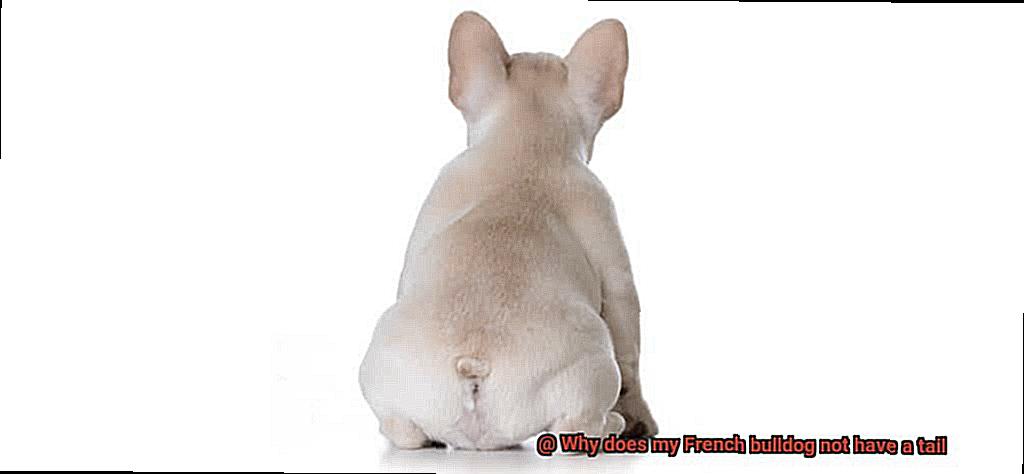Why does my French bulldog not have a tail?
French bulldogs are undeniably captivating creatures, with their unmistakable charm and lovable nature winning hearts all over the globe. But there’s one thing about them that often leaves people scratching their heads – or rather, wagging their own tails in confusion: where is theirs? Yes, you read that right – these adorable canines have a knack for rocking a tail-less look that sets them apart from their furry counterparts. So, what’s the deal with these tail-less wonders?
In this blog post, we’re going to dive into the intriguing history and genetic quirks behind why French bulldogs come tail-free. Join us as we unravel the mysteries and share some fascinating anecdotes about these unique derrieres. Let’s get to the bottom of it.
The Breed Standard for French Bulldogs
Contents
- 1 The Breed Standard for French Bulldogs
- 2 Brachyury: The Genetic Mutation Behind the Taillessness of French Bulldogs
- 3 Body Structure: How Does it Affect the Tail?
- 4 Health Risks and Benefits of Not Having a Tail
- 5 Variations in Tail Length Amongst French Bulldogs
- 6 Is a Longer Tail Considered Less Desirable?
- 7 Conclusion
In this article, we will delve into the breed standard for French Bulldogs, exploring the genetic factors that contribute to their taillessness and understanding the practical benefits it brings.
Understanding the Breed Standard:
The breed standard for French Bulldogs serves as a guideline established by kennel clubs and breed organizations, such as the American Kennel Club (AKC) and the Fédération Cynologique Internationale (FCI). It outlines the ideal characteristics and physical traits that a French Bulldog should possess to be considered a purebred representative of the breed.
Tail: Short, Straight, and Set Low:
According to the AKC’s breed standard for French Bulldogs, the tail should be “undocked, short, set low, thick at root, tapering quickly towards tip, preferably straight.” While French Bulldogs may have a short tail, it should not be absent or docked. In fact, the absence of a tail is not desirable in this breed.
Genetic Factors:
The absence of a tail in French Bulldogs is not due to any genetic abnormality or health issue. Rather, it is a result of natural variation caused by a genetic mutation called brachyury. This mutation affects the development of the tail during embryonic growth, resulting in an extremely short or absent tail. Over time, this genetic variation has been passed down through generations and became a defining characteristic of the breed.
Benefits of Taillessness:
The lack of a tail in French Bulldogs has practical advantages. Their short tails make them less prone to injury or damage from wagging against objects or getting caught in things. Additionally, having no tail can prevent issues like “happy tail syndrome,” a condition where the tail repeatedly hits against hard surfaces, leading to injury or infection.
Variations within the Breed:
While the breed standard calls for a short tail, variations can be found within the French Bulldog breed. Some individuals may have slightly longer tails or even small “screwtails” with a slight curve. As long as these variations remain within acceptable limits defined by the breed standard, they do not affect the overall quality of the dog.
Brachyury: The Genetic Mutation Behind the Taillessness of French Bulldogs
French Bulldogs, with their adorable wrinkly faces and bat-like ears, possess a distinctive feature that sets them apart from other breeds – their taillessness. This unique trait is a result of a genetic mutation known as Brachyury, which unravels an intriguing world of gene mutation and its impact on our tailless furry friends.
Brachyury: The Key Player
At the heart of French Bulldogs’ taillessness lies the Brachyury gene. This gene is responsible for the development of the tail and spinal column in vertebrates. In French Bulldogs, a mutation in this gene leads to the absence or shortening of the tail. It follows an autosomal recessive inheritance pattern, requiring both parents to carry the mutated gene for it to manifest in their offspring.
Disrupting Development
While the exact mechanisms behind how the Brachyury mutation affects tail development in French Bulldogs are not yet fully understood, researchers believe it disrupts the normal embryonic development of the tail. As a result, French Bulldogs are born without a tail or with only a stub.
Beyond Taillessness
The impact of the Brachyury mutation extends beyond just taillessness. Studies have revealed that this genetic alteration can also give rise to other skeletal abnormalities in French Bulldogs. These abnormalities may include malformations in the vertebrae and irregularities in the sacrum and coccygeal vertebrae. Such skeletal issues can potentially affect overall health and mobility in affected dogs.
Health Risks
The presence of the Brachyury mutation in French Bulldogs also increases the risk of intervertebral disc disease, a condition characterized by back pain and mobility problems. It is vital for owners of these tailless companions to be aware of these potential health risks and provide appropriate care and monitoring.
Responsible Breeding for a Healthier Future

To mitigate the prevalence of the Brachyury mutation and its associated health concerns, responsible breeding practices are crucial. Genetic testing should be conducted to identify carriers of the mutation, and breeders should avoid mating dogs that carry the mutated gene. By prioritizing responsible breeding, we can ensure the well-being of French Bulldogs with fewer skeletal abnormalities.

Body Structure: How Does it Affect the Tail?
French bulldogs, known for their unique body structure, captivate us with their adorable tailless appearance. But have you ever wondered how their body structure affects their tail? Let’s embark on a fascinating journey into the world of French bulldogs and unravel the connection between their body structure and their tail, or lack thereof.
At first glance, French bulldogs stand out with their compact and muscular build, paired with a short and stocky stature. This distinct body structure is key to understanding their tailless nature. You see, French bulldogs possess a rare genetic mutation called brachyury. This mutation impacts the development of the tail during their embryonic stage, resulting in either a short, screw-like tail or no tail at all.
Now, fear not, dear readers. The absence of a tail does not compromise the overall health or well-being of these delightful companions. In fact, it is believed that their tailless state actually enhances their balance and stability, making them exceptional companion dogs.
But that’s not all. The body structure of French bulldogs also contributes to their agility and movement. Their compact build and low center of gravity grant them remarkable dexterity, allowing them to navigate tight spaces with ease. Without a tail to worry about, they can effortlessly maneuver through obstacles without any hindrance.
Moreover, the absence of a tail spares French bulldogs from the controversial practice of tail docking. This surgical procedure, often performed for cosmetic purposes in other breeds, involves removing a dog’s tail. By being naturally tailless, French bulldogs get to keep their distinctive appearance intact while avoiding unnecessary procedures.
Now you may be wondering if French bulldogs truly lack a tail entirely. While they may appear completely tailless to the naked eye, they possess a small bony structure called the coccygeal vertebrae at the base of their spine. This vestigial tail is usually not externally noticeable but can be felt upon touch, a subtle reminder of their ancestral connection to tailed canines.
So, French bulldog owners, embrace the charm of your tail-free companions. Their unique body structure ensures their balance, agility, and carefree navigation through life. Celebrate their natural beauty and relish in the joys of having a French bulldog with an adorable wiggle that captures the hearts of all who encounter them.
Health Risks and Benefits of Not Having a Tail
French bulldogs are famous for their unique appearance, particularly their tailless or short-tailed feature. While this may be an endearing characteristic, it is important for French bulldog owners to understand the potential health risks and benefits associated with not having a tail. In this comprehensive guide, we will explore the intriguing world of tailless wonders and delve into the various aspects of their health.
Spinal Problems:
One significant health risk that French bulldogs without a tail face is an increased susceptibility to spinal problems. The tail serves as an extension of the spine, providing balance and stability during movement. Without a tail, these dogs may be more prone to spinal injuries and conditions such as intervertebral disc disease. It is crucial for owners to monitor their French bulldog’s spinal health closely and seek veterinary attention at the first sign of discomfort or abnormality.
Communication Challenges:
Tail wagging is a universal language among dogs, conveying emotions and intentions. Unfortunately, French bulldogs without a tail may struggle to communicate effectively with other dogs. This can lead to misunderstandings and difficulties in socializing with fellow canines. As responsible owners, it is important to be mindful of this limitation and find alternative ways to promote positive interactions between your tailless wonder and other furry friends.
Reduced Risk of Tail Injuries:
On the flip side, not having a tail offers some benefits for our French bulldog companions. The absence of a tail significantly reduces the risk of tail injuries, such as getting caught in doors or being accidentally stepped on. These injuries can be painful and may require medical intervention. With a tailless wonder by your side, you can enjoy peace of mind knowing that they are less prone to such accidents.

Grooming Made Easier:
Maintaining proper hygiene for our furry friends is essential. Without a tail, grooming becomes a breeze for French bulldog owners. Tails can often collect dirt, debris, and even fecal matter, leading to skin irritations and infections. With fewer nooks and crannies to clean, grooming becomes less time-consuming, allowing you to focus on other aspects of your French bulldog’s well-being.
Variations in Tail Length Amongst French Bulldogs
French Bulldogs have captured the hearts of many with their irresistibly cute appearances, and one of their most distinctive features is their tail, or in some cases, the lack thereof. Yes, it’s true that not all French Bulldogs have a tail. In fact, there are fascinating variations in tail length amongst these delightful companions. So, let’s embark on a journey into the captivating realm of French Bulldog tails and unravel the potential health implications that come with these unique variations.
The Intriguing Screw Tail Gene:
The absence of a tail in French Bulldogs can be attributed to an intriguing genetic mutation known as the “screw tail” gene. This genetic anomaly affects the development of the tail vertebrae, resulting in either a short or curled tail. It’s truly remarkable how this distinctive characteristic is inherited from both parents and is more prevalent in specific bloodlines.
Unveiling the Origins of the Screw Tail Gene:
The origins of the screw tail gene can be traced back to selective breeding practices aimed at achieving a desired appearance. Breeders favored French Bulldogs with shorter tails, leading to the perpetuation of this genetic trait within certain bloodlines. It’s astonishing how human preferences have played a role in shaping the physical attributes of these lovable canines.
Delving into Variations in Tail Length:
While many French Bulldogs possess no tail at all, others may exhibit a short but visible tail. These variations in tail length can be influenced by other genetic factors or mutations that interact with the screw tail gene. It’s like a unique twist in each dog’s genetic makeup, adding even more charm to these already irresistible creatures.
Balancing Cosmetics and Health Considerations:
The length of a French Bulldog’s tail is purely a cosmetic characteristic and does not cause any functional issues for the dog. So, if your Frenchie sports a short or no tail, rest assured that it doesn’t impact their overall health or well-being. They continue to be as energetic and affectionate as ever.
The Importance of Responsible Breeding:
It is crucial to be mindful of responsible breeding practices. Breeding two French Bulldogs carrying the screw tail gene may increase the likelihood of certain health issues associated with this mutation. These can include spinal deformities, neurological problems, and difficulties with bowel movements. To minimize these risks, responsible breeders prioritize selecting mates that do not carry the screw tail gene.
Conclusion:
Variations in tail length amongst French Bulldogs are a result of the intriguing screw tail gene, a genetic mutation that has shaped their appearance over generations. While it’s an endearing and unique characteristic, it’s essential to prioritize the health and well-being of our furry friends.
By adhering to responsible breeding practices and seeking guidance from reputable breeders who prioritize health, we can ensure that our French Bulldogs lead happy and healthy lives.
Is a Longer Tail Considered Less Desirable?
French Bulldogs are known for their distinctive appearance, and one of their most recognizable features is their short, stubby tail. This raises an interesting question: is a longer tail considered less desirable for French Bulldogs? To answer this question, it’s important to understand the history and purpose behind the French Bulldog’s tail.
Originally bred in the 1800s as ratting dogs, French Bulldogs needed a tail that wouldn’t get in the way while they were busy catching rodents. Their short tails were intentionally bred for functional reasons, making them less susceptible to injuries during their ratting activities.
However, as French Bulldogs transitioned from working dogs to beloved family pets, breeders started focusing more on aesthetics rather than functionality.
The short tail became a defining characteristic of the breed, and longer tails came to be seen as less desirable in terms of adhering to the breed standard. It’s important to note that the length of a French Bulldog’s tail doesn’t directly affect their health or well-being.
It’s purely a matter of cosmetic preference among breed enthusiasts and show judges who evaluate dogs based on how closely they adhere to breed standards.
While a longer tail may not conform to breed standards, it doesn’t impact your French Bulldog’s overall health or quality of life. Whether your furry friend has a short or long tail, they can still live a happy and fulfilling life as your loving companion.
Don’t let the length of your French Bulldog’s tail be a determining factor when considering their suitability as a family pet.
Conclusion
In conclusion, the absence of a tail in French Bulldogs is not a result of any genetic abnormality or health issue. It’s simply a natural variation caused by a genetic mutation known as brachyury. This quirky mutation affects the development of the tail during their early stages of growth, resulting in an incredibly short or non-existent tail.
As time went on, this unique genetic trait was passed down through generations and became one of the breed’s defining characteristics.
But why is having no tail actually advantageous for French Bulldogs? Well, their cute little rumps are less prone to injury or damage from wagging against objects or getting caught in things. And let’s not forget about “happy tail syndrome,” a condition where a dog’s tail repeatedly smacks against hard surfaces, causing painful injuries and infections. Thankfully, our tailless Frenchies are spared from this unfortunate fate.
Now, it’s important to note that there can be some variations in tail length within the French Bulldog breed. However, as long as these variations fall within acceptable limits defined by the breed standard, they don’t impact the overall quality of the dog.
Understanding the genetics and practical benefits behind why French Bulldogs have no tails allows us to truly appreciate and celebrate their unique appearance.
By prioritizing responsible breeding practices and seeking guidance from reputable breeders who prioritize health above all else, we can ensure that our beloved Frenchies lead lives filled with happiness and vitality.




